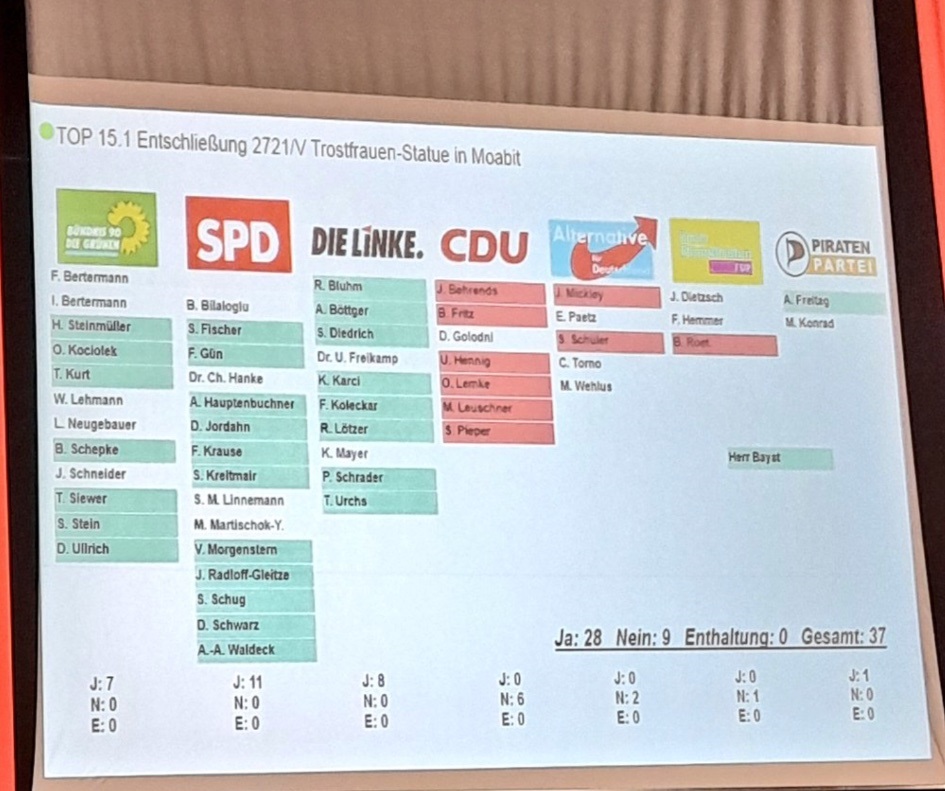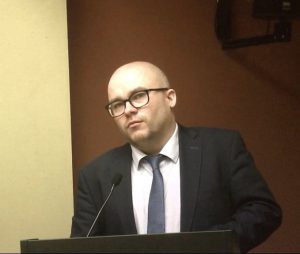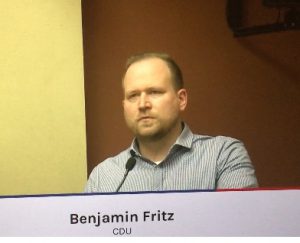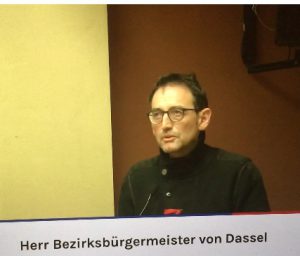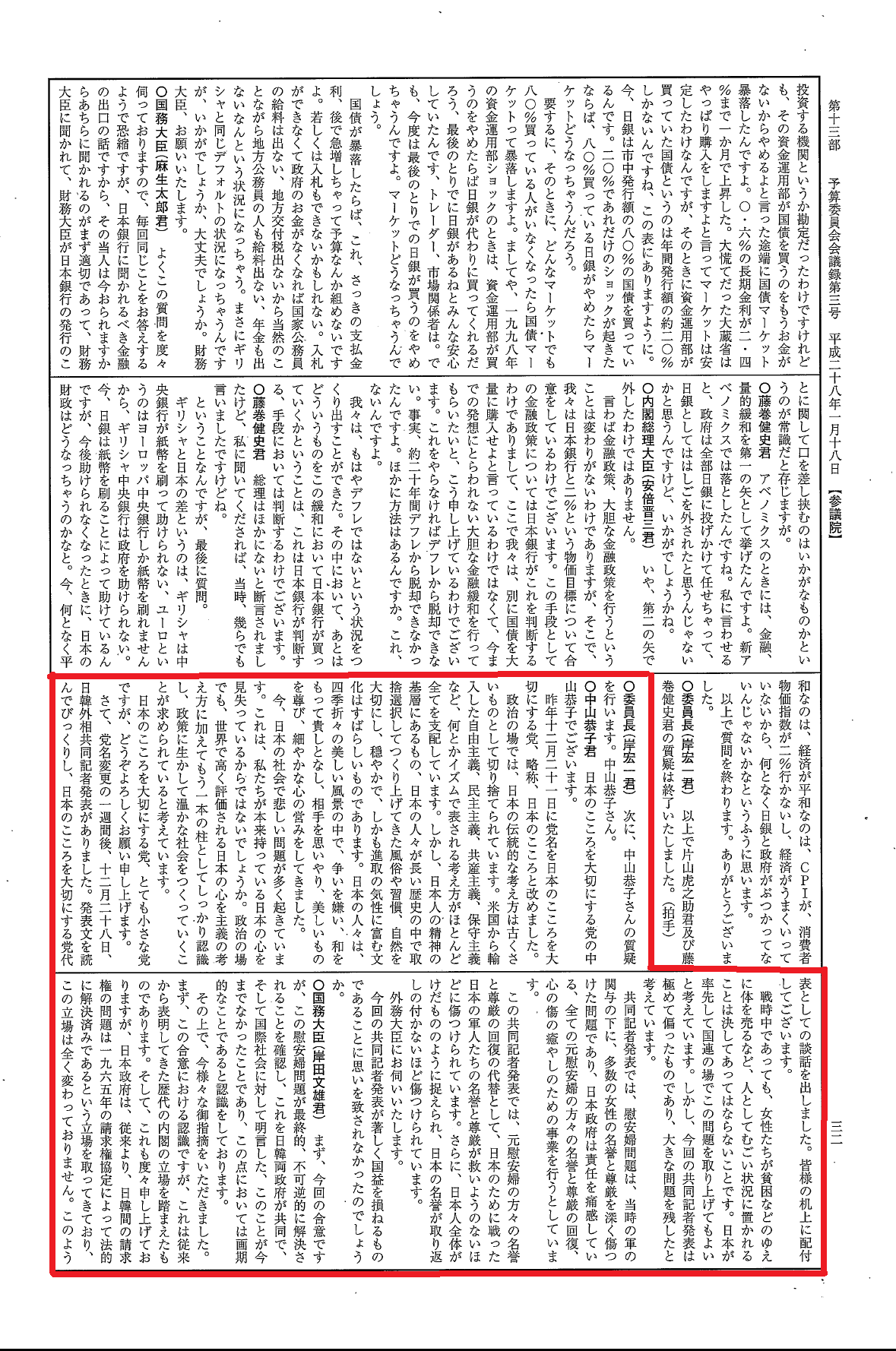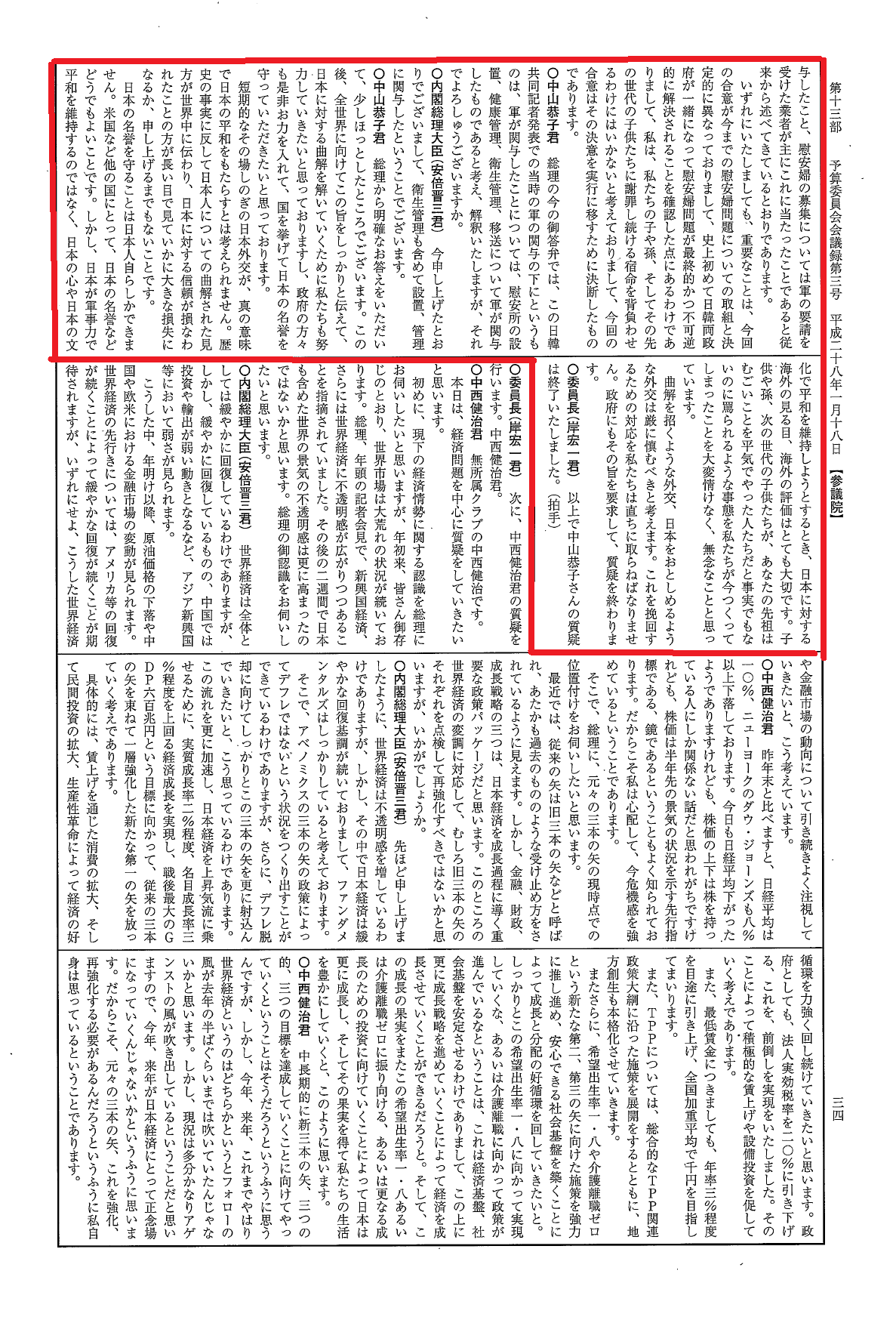慰安婦像が公共の場所に建っているドイツ・ベルリンのミッテ区長と関係者、メディア宛に「Appell an Sie und an alle Berliner,bitte öffnen Sie die Augen und wachen Sie endlich auf! (あなたとBerlinの人々に伝えます。目を見開いて下さい!)」のタイトルで以下の文面の書簡(原文ドイツ語)を送りましたのでご紹介します。
原文 ドイツ語 Deutsche German 【 WEB 】 【 PDF 】PDF 】
*******************************************************************************
2020年10月30日
ベルリン ミッテ 区 シュテファン・フォン・ダッセル 区長 殿
あなたとBerlinの人々に伝えます。目を見開いて下さい!
私は「なでしこアクションJapanese Women for Justice and Peace」の代表の山本優美子と申します。当会は世界中の母親を中心とする日本女性の会です。私は、慰安婦問題を懸念する全ての日本人女性に代わってこの文書を送ります。
先ず最初にお伝え致します。この文章には主観的、感情的な記述が多く見られますが、理由は韓国の卑劣な活動に我慢がならず、もうたくさんと言う気持ちから、思うままに文を纏めます。韓国の嘘を何の疑いも無く信じ韓国に味方するあなた方とメディアそして不見識な知識人を啓蒙することも目的としたアピールでもあります。
要約
1. 韓国の卑劣さ
1. 韓国の卑劣さ
新聞報道とベルリン,ミッテ区のプレスリリースに対して下記、意見をお伝え致します。
ベルリン、ミッテ区でのコリア協議会の虚偽の申請による被害者はあなた方と日本そして日本人です。この様な韓国の嘘とそれを基にしたプロパガンダそして異常なストーカー的な韓国の活動に我々日本人は大変疲れ国交断絶を望む声も高くなり日本人の約70%が嫌韓感情を持ち今回の事件で更に嫌韓が増加となることは確実です。
今回の慰安婦像設置での韓国KBS Worldのニュースでは“この像の設置に対する日本政府による妨害も予想されたのでコリア協議会は申請手続きを特に慎重に進めた”と日本そして貴方を欺き成果を誇るアナウンスメントにはずる賢さと、その考えに邪念しか無いのが分かります。碑文にも刻まれていますが意図的に日本人と日本を貶め憎しみを助長させる言葉とそれを公開する行為、そして事もあろうか関係の全くない第三国ドイツを巻き込む理由は何なのか?お考えになられた事ありますか? それは告げ口、中傷に他なりません。韓国は意図的に日本より経済的に強国か日本と同等な国を選んだのです。それはアメリカとドイツの2か国なのです。日本、日本関係の組織そして日本人に対する誹謗中傷は事実と証拠から到底受け入れることはできません。
2. コリア協議会は詐欺団体の手先
設置を主導した組織はコリア協議会とありますが韓国の正義連(略称)の全面的な資金を含めた援助を受けております。この団体と主催者である人物は慰安婦を看板として韓国のみならず世界の人々の同情を利用して募金を呼びかけ、その募金の殆どを慰安婦に渡さず着服したことで慰安婦を含め献金者や税務署から告発され6件の罪名で起訴されております。
主催者で悪の元凶である尹美香(ユン・ミヒャン)被疑者は今年の選挙で与党から出馬して国会議員に当選した為、逮捕は免れていますが韓国では今、一大スキャンダルとなっております。発端は看板慰安婦の李容洙(*0)から詐欺疑惑ありと非難され、それに対して尹美香は李容洙が最初の電話で「自分は被害者(慰安婦)ではなく友達が被害者だ」と言ったことを知っていながら30年間彼女と活動を共にしたことが発覚し、醜い争いがエスカレートしています(*1,*2,*3)。この市民団体の反日運動はただ単に金儲けであり不正の温床、犯罪人の巣窟です。彼らの活動を支持しなくとも容認するドイツ人は同じ犯罪人であると言えます。
コリア協議会はミッテ区に戦争時の女性への性暴力の記憶として平和の像の設置を申請した様ですが設置された碑文にある日本軍による20万人の強制連行と性奴隷は全くの嘘の物語で日本政府、外務省のホームページで明確に否定しております(*4) 尚、韓国政府はこの慰安婦問題そのものを正式に政府のホームページでは公表していません。
日本軍用の公娼慰安所は確かにありましたが、ドイツ軍のそれ、Mrs. Christa Paulの著書である“Naziによる国営強制売春宿”とは全く異なるものでした。日本がこの問題で謝罪した理由は日本軍が慰安婦の移送と健康診断に関与しただけで元来、謝る必要のない事でした。これが日韓関係をこじらせてしまった原因です。
3. 韓国の偽善 Lai Dai Han 事件と犯罪
日本軍による性奴隷はまったくの物語ですがこれから大問題として世界で大きく認知されるであろう事件はLai Dai Han (*5,*6,*7) で、この事件の内容を当然知っているコリア協議会の偽善は許されません。 これはベトナム戦争での韓国軍のベトナムに於ける虐殺と性犯罪で紛れもない“事実”です。
4. 碑文の嘘とその証明
碑文の内容が嘘である証拠として韓国の主張は証言ではなくただの“申し立て”でです。
5. 慰安婦問題の歴史と捏造
これに対して日本の反論は全て証拠に基づいております。先ず20万人の性奴隷、強制連行なぞ常識で考えても有り得ないどころか今日まで旧売春婦の両親や家族そして隣人や友人の証人や目撃者が誰一人いない事。それも戦後約45年後に嘘の韓国人連行物語により韓国で“金になる”と騒ぎだしたのが発端です。
そして当時の帝国陸軍の韓国人兵の存在があります。当時は韓国も台湾も日本が統治し“日本”であったことから日本軍に応募した韓国人、台湾人も多くあり韓国人兵だけでも24万2千人が日本帝国陸軍に登録。そのうち戦死者は22.100名。そして日本士官学校を卒業した韓国人は最高位の陸軍中将Hong Sa-ikとI Eunの両名を含み64名がおりました。彼ら韓国人士官と韓国兵は韓国人女性が性奴隷とされたと知って日本人と共に戦い命を犠牲にしたか?20万人の及ぶ韓国人女性の強制連行の事実を知らずに22.100人の韓国兵が日本に命を捧げたのか、又は韓国人は皆、臆病者だったのか。
この様な事に声を上げる韓国人そして復員兵は居ないのかと言う疑問に対する説明として韓国には現代の文明国では考えられない異常な法律、親日罪(*8)と言うものがあります。親日的な活動や発言をすると罰則が科せられ、日本統治時代に親日と見なされた人物とその子孫は財産を没収され本人と家族名が公表され公文書にリストアップとなる理不尽で異常な法律です。しかも遡及適応される事から親日的発言は一切封じられている事です。しかしながら、やっと昨年に数名の韓国学者が果敢にも立ち上がり、慰安婦問題を含め日本は悪と非難している全てが嘘であると証拠を基に反日種族主義Anti-Japan Tribalismと言う本を発刊し2019年7月のベストセラーになりました。(*9)
日本の敗戦により自動的に独立となった韓国は敗戦以降に誕生した反日政権による偏向報道と偏向教育から日本を悪と見る様になり、故に慰安婦問題に対しても正義連の活動に否定的な発言はできず、この団体はやりたい放題に今日まで活動しています。一方、同じく日本が韓国より長く統治した台湾は日本精神が今も受け継がれており大の親日国で韓国を“気が狂ったか”と見ております。
慰安婦問題が如何に捏造された嘘につき、なでしこアクションによる資料を (*10) に添付します。
更に証拠として次の2資料の存在を案内します。その何れもが米軍とアメリカ政府の公式資料であることです。
6. Report 49
先ずReport 49、US Office of War InformationでMyitkyin a in Burma.での韓国人慰安婦の克明な調書でPREFACEでA “comfort girl” is nothing more than a prostitute or “professional camp follower” attached to the Japanese Army for the benefit of the soldiersとの明記があります。(*11)。
7. IWG Report
次に The Report of the Nazi War Crimes and Japanese Imperial Government Records Interagency Working Group (*12)
8. IWG Report 2007 Final
このReportの §2 The nature of war crimes record 8 ページに記載のある日本の犯罪記録で“スタッフは戦争犯罪に関する証拠は何も見つけられなかった”と明記されており韓国の嘘がここでも立証されています。(*13)
当時の米国は我々、日本とドイツの敵であり特に日本に対して行った原爆投下と東京を含め5都市を無差別爆撃で焦土化し約59万人の民間人を殺戮した戦争犯罪はホロコーストに類似する悪行でした。それを正当化する為に米国は日本の戦争犯罪を戦後、特に熱心に調べ上げたが定義されているところの戦争犯罪は皆無とのレポートを2007年に公表しました。
9. 韓国人の特技 – 嘘 –
以上の状況説明と掲載した証拠資料により、韓国の申し立てと声明が嘘であることを納得頂けた事と思います。韓国人は論理と事実を無視する傾向が強く反論はことごとく感情的です、日本の様に証拠を基に論理的に説明することを一切しません。仮に韓国人がこの啓蒙文を読み反論しても、それは証拠を基にした反論ではなく感情論です。もし彼らの反論で証拠として当時の写真類と説明文がある場合は全てが日本の物を盗用しており、説明文は作り話です。日本はこれまで何十と言う韓国の偽造、偽証、嘘を暴いております。
―最後に大事なことー
朝鮮人の殆どは誇大妄想、大言豪語に加え遺伝と訓練による疑いの余地のない嘘つきである。
正義と悪は明白ですが、あなたはそれでも韓国の声明を信じ悪に加担し続けるのでしょうか?
貴方とベルリンの人々は目を開けて下さいと今一度伝えます。
もし貴方に疑問や質問あれば是非お問い合わせください。全てのご連絡には必要に応じ証拠を基にご返事致します。言語は勿論ドイツ語でも構いません。
敬具
なでしこアクション http://nadesiko-action.org/
****************************************************
[ 出典 ]
0. Lee Yong-soo https://en.wikipedia.org/wiki/Lee_Yong-soo_(activist) https://www.youtube.com/watch?v=JFfaJJz_jB0
1. Yoon Mee-hyang https://en.wikipedia.org/wiki/Yoon_Mee-hyang
2. Jurist SEPTEMBER 15, 2020 South Korea sexual exploitation activist charged with fraud and embezzlementhttps://www.jurist.org/news/2020/09/south-korea-sexual-exploitation-activist-charged-with-fraud-and-embezzlement/ http://www.koreaherald.com/view.php?ud=20200914000899
3. Opinion to the United Nationshttp://nadesiko-action.org/wp-content/uploads/2020/05/HRC_44_NGO_JSHT_item4_En.pdf
4. Japan’s Efforts on the Issue of Comfort Womenhttps://www.mofa.go.jp/policy/postwar/page22e_000883.html https://www.mofa.go.jp/files/000473133.pdf
5. Lai Đại Hànhttps://en.wikipedia.org/wiki/Lai_%C4%90%E1%BA%A1i_H%C3%A0n
6. Women raped by Korean-soldiers during Vietnam war-still-awaiting-apologyhttps://www.theguardian.com/global-development/2019/jan/19/women-raped-by-korean-soldiers-during-vietnam-war-still-awaiting-apology
7. Justice for Lai Dai Hanhttps://www.youtube.com/watch?v=QThQ029MnPQ https://www.youtube.com/watch?v=eAyBSZMzVao
8. Special act on asset confiscation for Pro-Japanese and Anti-National collaborators to the Statehttps://law.go.kr/LSW/lsInfoP.do?lsiSeq=113181&viewCls=engLsInfoR&urlMode=engLsInfoR#0000
9. Anti-Japan Tribalismhttps://en.wikipedia.org/wiki/Anti-Japan_Tribalism
10. Comfort Women Not Sex Slaves but Prostitutes Looking into Historical Evidence – Neglected Facts and Voices –http://nadesiko-action.org/wp-content/uploads/2015/08/Comfort-Women-Not-Sex-Slaves_FINAL_annex.pdf
11. Japanese Prisoner of War Interrogation Report 49https://en.wikisource.org/wiki/Japanese_Prisoner_of_War_Interrogation_Report_49
12. IWG Report Nazi War Crimes and Japanese Imperial Government Records Interagency Working Grouphttps://en.wikipedia.org/wiki/Nazi_War_Crimes_and_Japanese_Imperial_Government_Records_Interagency_Working_Group
13. IWG Report Final Report to the United States Congress, April 2007https://www.archives.gov/iwg/reports/final-report-2007.html https://www.archives.gov/files/iwg/reports/final-report-2007.pdf
14. Chogabje. com 거짓말공화국: 위증이 일본의 671배, 사기는 17배, 무고는 4151배!http://www.chogabje.com/board/view.asp?C_IDX=43738&C_CC=AD
**************************************************
【 参考 他 ベルリン慰安婦像に対する抗議書簡 】
◆ An Open Letter Regarding the “Peace Statue” in Berlin Mitte District from Miroslav Marinov, Ph.D.http://nadesiko-action.org/?p=15469
◆ 韓国市民団体「慰安婦法廃止国民行動」がミッテ区長へ送った声明文https://blog.naver.com/cleanmt2010/222117303193 http://www.sdh-fact.com/CL/Berlin_e.pdf
◆ MAX VON SCHULER-KOBAYASHI 氏 (ドイツ系米国人、元米軍人、軍事歴史評論家、日本語での著書6冊)https://note.com/max_japan_num1/n/nb94d3c5d596b
◆ Australia-Japan Community Networkhttps://jcnsydney.blogspot.com/2020/10/ajcn.html
◆ Minoru Kiuchi -城内実 衆議院議員-VIDEO

